The Importance of Family Therapy in Autism
Supporting Families for a Brighter Future with Autism

Understanding the Critical Role of Family Therapy in Autism Support
Family therapy stands as a cornerstone in the multi-faceted approach to supporting individuals with autism spectrum disorder (ASD). By actively engaging families, tailored interventions, and collaborative care, family therapy enhances not only the developmental progress of individuals with autism but also the overall well-being of their families. This article explores the vital importance of family-centered care, effective strategies to strengthen family dynamics, and how various family therapy approaches play a pivotal role in enhancing outcomes for individuals with ASD.
The Foundations of Family Therapy in Autism Support
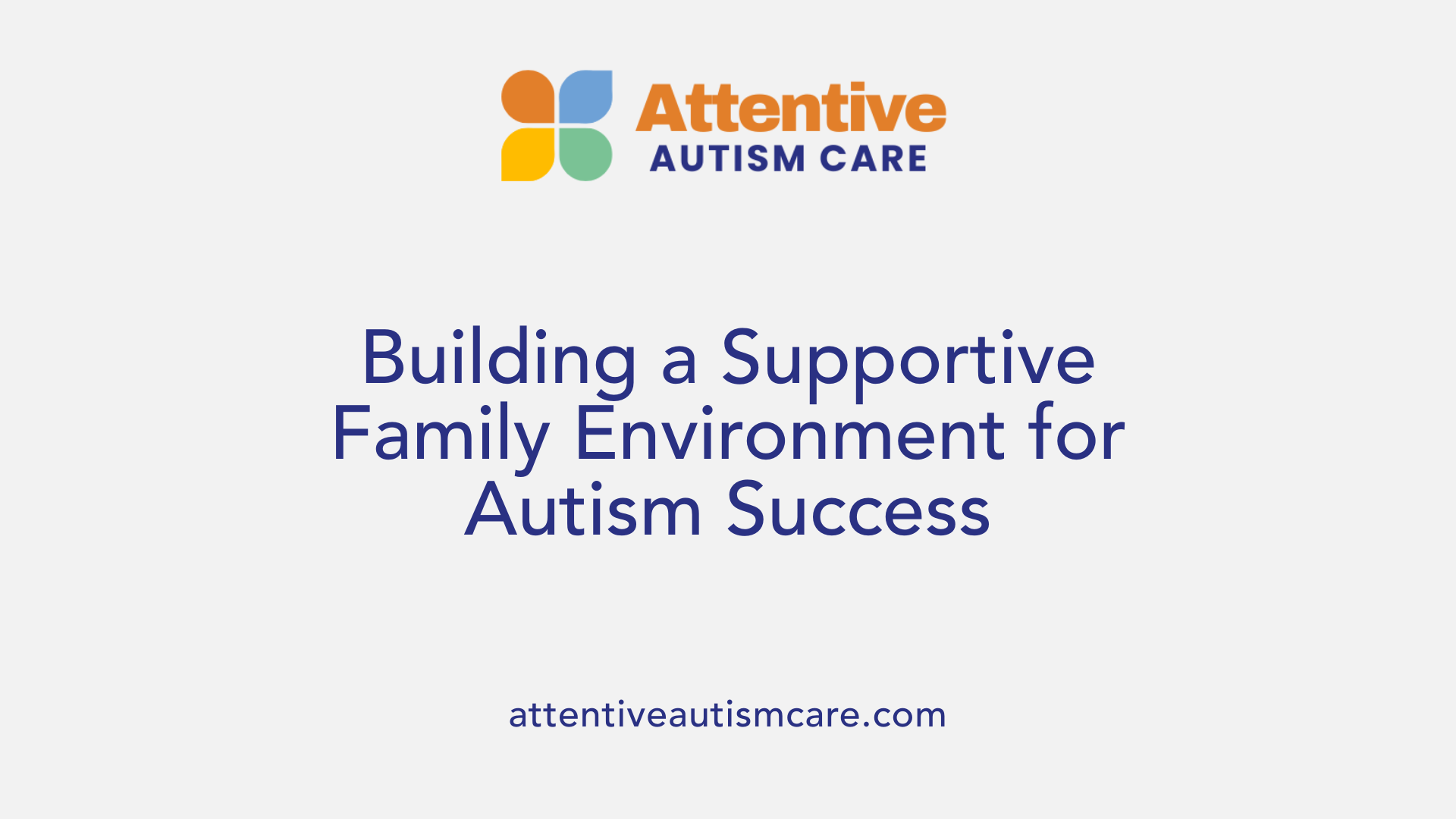
What is the role of family therapy in autism support?
Family therapy is vital in supporting families with members on the autism spectrum. It actively involves the whole family in the treatment process, helping to improve communication, understanding, and strategies for coping with daily challenges.
This approach ensures that interventions align closely with family goals and values by engaging families in planning, executing, and assessing therapy. By doing so, it fosters a more supportive and resilient environment for individuals with autism.
Family-centered care, a core principle in autism support, emphasizes collaboration and mutual respect. Therapists provide resources, guidance, and emotional support, which can lead to better developmental outcomes such as improved social skills and communication.
Additionally, family therapy helps address family dynamics that may impact the well-being of both the individual with autism and their relatives. It reduces caregiver stress through education and coping strategies, creating a healthier family atmosphere.
Innovative methods like telehealth have expanded accessibility, allowing families to receive ongoing support regardless of geographical barriers. These remote options facilitate continuous engagement, personalized assistance, and stronger collaboration among families, therapists, and educators.
In summary, family therapy plays an essential role in creating a comprehensive support system that improves family functioning, reduces stress, and promotes positive development for individuals with autism.
Goals and Benefits of Family-Centered Autism Therapy
Why is family-centered care important in autism interventions?
Family-centered care plays a vital role in autism therapy because it recognizes families as essential partners in the intervention process. Parents and family members usually know their child best, providing critical insights into their strengths, needs, and daily challenges. When families are actively involved, interventions are more personalized and relevant, leading to better outcomes.
This approach ensures that strategies and skills learned in therapy are reinforced at home and in natural settings, promoting consistency and generalization of skills. Engaging families also helps reduce their stress and builds resilience, giving them confidence in supporting their child's growth.
Moreover, collaborative care fosters trust, improves communication between families and professionals, and makes interventions more sustainable over time. Overall, family-centered care leads to a more holistic, effective, and empowering experience for families navigating autism support.
Improving social interaction and emotional regulation
A core goal of family therapy is to enhance social skills and emotional regulation in children with ASD. Therapies such as Applied Behavior Analysis (ABA) and Cognitive Behavioral Therapy (CBT) target behaviors that improve communication, social engagement, and emotional control. These interventions help children learn to connect with others, understand emotions, and express feelings appropriately.
Enhancing understanding of ASD among parents
Family therapy educates parents about autism spectrum disorder, helping them better understand their child's behaviors and developmental needs. This increased knowledge empowers parents to implement effective strategies at home, manage challenging behaviors, and advocate for their child's needs in educational and community settings.
Fostering a supportive and accepting family environment
Creating an accepting atmosphere reduces misunderstandings and promotes positive interactions within the family. Therapy encourages open communication, emotional support, and the use of positive reinforcement, which strengthens family bonds. It helps family members develop patience, empathy, and collaborative problem-solving skills.
Developing coping strategies for stress
Raising a child with autism can be stressful. Family therapy introduces coping mechanisms such as mindfulness, routine management, and access to support networks. These strategies help families manage stress effectively, improve overall well-being, and maintain a hopeful outlook.
| Aspect | Therapy Focus | Expected Outcome |
|---|---|---|
| Social Skills | ABA, DIR | Improved social engagement |
| Emotional Control | CBT | Better emotional regulation |
| Family Understanding | Education, Support | Increased ASD awareness |
| Family Environment | Support, Communication | Supportive, accepting home |
| Stress Management | Mindfulness, Routines | Reduced family stress |
Fostering these areas creates a nurturing environment where children with autism can thrive and families can feel more confident and resilient.
Strategies to Improve Family Dynamics and Support Systems
What strategies can improve family dynamics and support for individuals with autism?
Supporting families with members on the autism spectrum involves a range of effective methods aimed at enhancing communication, collaboration, and overall family functioning. Central to these strategies is creating a family-centered approach, where family members are active participants in therapy planning and decision-making.
One of the most effective ways to improve dynamics is through clear, respectful communication. Techniques such as active listening, visual aids, and dedicated family time foster better understanding and reduce misunderstandings. Encouraging open dialogue helps family members express their feelings and concerns, building emotional strength and cohesion.
Involving families directly in therapy and intervention planning is crucial. Early intervention programs that include caregivers not only support skill generalization but also empower families to reinforce positive behaviors and developmental milestones at home. This involvement promotes a consistent approach, which is vital for children with autism.
Utilizing evidence-based approaches like Naturalistic Developmental Behavioral Interventions (NDBIs), JASPER (Joint Attention, Symbolic Play, Engagement, and Regulation), and parent-mediated interventions can significantly enhance social interaction and communication skills. These methods emphasize caregiver involvement and natural settings, making learning more relatable and effective.
The integration of technology and telehealth services has expanded access to autism support. Telehealth enables families, especially those in remote or underserved areas, to connect with specialists without the need for travel. Online resources, virtual training, and digital tools provide continuous support and learning opportunities.
Providing educational resources, advocating for families, and establishing peer support networks are additional ways to bolster family resilience. Stress reduction programs, counseling, and stress management workshops help families cope with emotional pressures, fostering a supportive environment for everyone involved.
Fostering ongoing, respectful partnerships between families and professionals is fundamental. Such collaborations ensure interventions are tailored to each family’s needs and cultural context, ultimately creating a nurturing environment that promotes positive development across the lifespan of individuals with autism.
| Strategy Category | Description | Examples |
|---|---|---|
| Communication & Collaboration | Enhancing family communication and teamwork | Active listening, visual supports, family meetings |
| Family Involvement | Engaging families in therapy and planning | Caregiver training, joint goal setting |
| Evidence-Based Approaches | Using research-backed methods | NDBIs, JASPER, parent-mediated interventions |
| Technology & Telehealth | Expanding access and support | Virtual consultations, online resources |
| Support & Education | Building family resilience | Stress reduction, peer networks, advocacy |
By prioritizing these strategies, families are better equipped to navigate the complexities of ASD, creating a supportive, empowered environment that fosters growth and well-being for their loved ones.
Managing Autism Challenges through Family Therapy
How can family therapy help manage autism-related challenges?
Family therapy plays a vital role in addressing the complex needs of families with members on the autism spectrum. One of its main contributions is improving communication within the family, which often becomes strained due to challenges related to ASD. Techniques such as active listening, visual aids, and role-playing foster better understanding and reduce misunderstandings.
By strengthening relationships, therapy helps diminish emotional conflicts and boosts cohesion among family members. This supportive atmosphere allows families to collaboratively develop tailored strategies that promote social skills and emotional regulation for individuals with autism.
Moreover, family counseling equips parents and caregivers with effective coping mechanisms. These include stress management techniques like mindfulness, establishing routines, and utilizing support networks, which are crucial for maintaining emotional resilience.
Therapists also assist families in navigating systemic barriers by providing guidance on accessing educational and healthcare resources. Engaging in advocacy and advocating for appropriate services can alleviate caregiver stress and improve developmental outcomes.
Creating a nurturing environment for siblings and extended family members is another benefit. Family therapy promotes understanding and acceptance, thereby fostering a cohesive unit that supports the individual with autism.
Ultimately, a holistic, family-centered approach supports emotional well-being, improves family dynamics, and helps meet the evolving developmental needs of individuals with autism. Regular assessments and tailored interventions ensure that families can adapt to new challenges and celebrate progress together.
The Significance of Collaboration in Autism Care
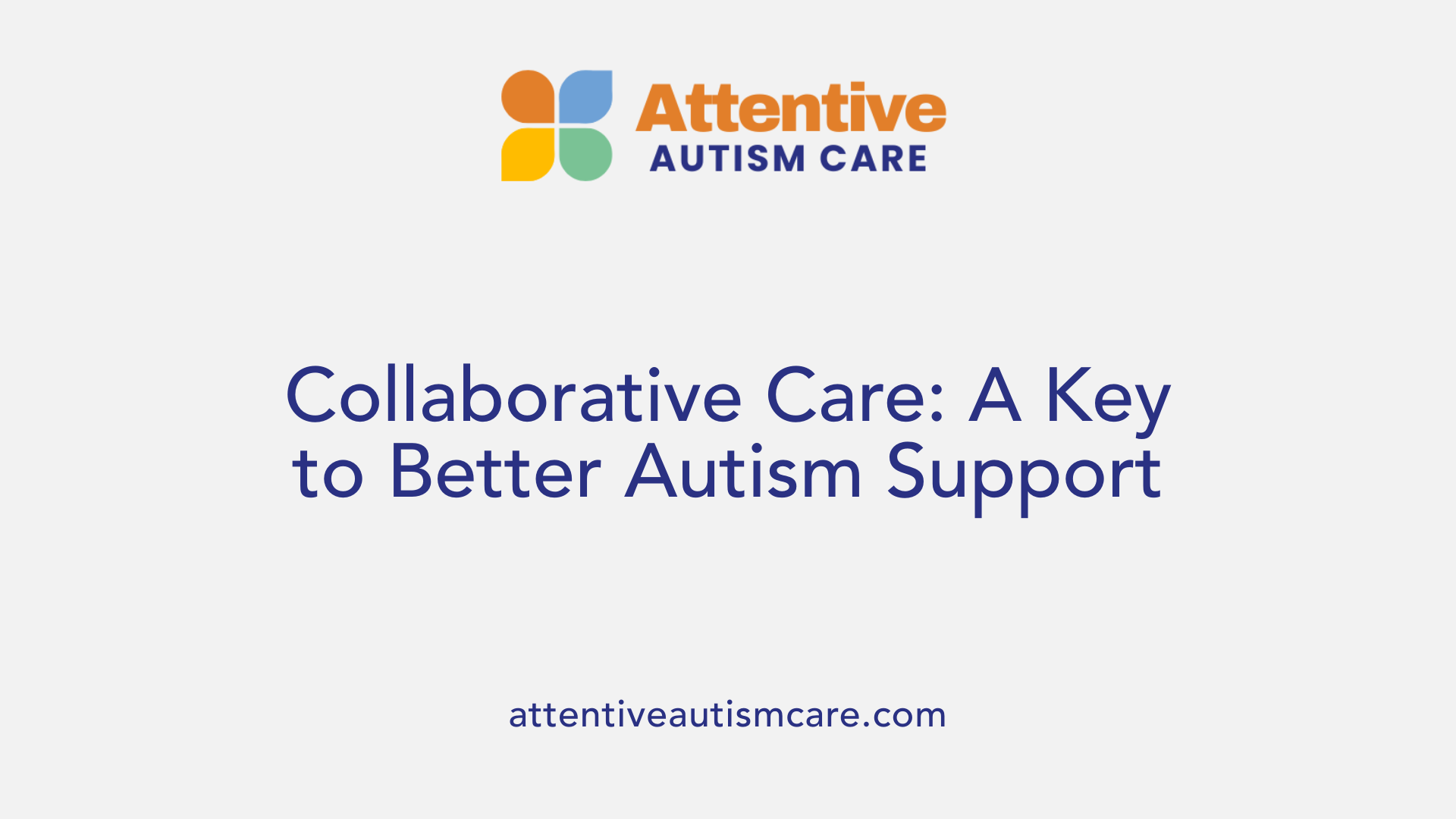
What is the significance of collaborative family participation in autism care?
Active involvement of families in autism treatment is vital for achieving successful outcomes. When families participate directly in treatment planning and execution, they become empowered to support their child's development effectively. This partnership fosters greater engagement with therapies such as Applied Behavior Analysis (ABA) and parent-mediated interventions, ensuring these methods are tailored to the child’s specific strengths and challenges.
Families offer valuable insights into their child's unique needs, behaviors, and preferences. This detailed understanding allows therapists to develop personalized support strategies, increasing the likelihood of positive progress. For example, incorporating family feedback can enhance social skills training or emotional regulation approaches, ensuring interventions are relevant and practical.
Involvement extends beyond the immediate therapy sessions. Parents, siblings, and extended family members all play roles in reinforcing learning and behavior management at home, school, and community settings. This consistency strengthens the child's social, emotional, and behavioral development.
Furthermore, active family participation contributes to the resilience of the entire family unit. It helps parents better manage stress, reduces feelings of helplessness, and promotes a proactive outlook. Regular communication and shared decision-making between families and care providers build trust and create a supportive environment, easing the transition across educational, social, and community transitions.
In essence, when families are engaged in the treatment journey, the entire support system becomes more cohesive and responsive. This collaboration not only enhances the child’s developmental trajectory but also fortifies the family’s capacity to cope with ongoing challenges, leading to improved overall well-being and quality of life.
The Role of Family Therapy in Improving Developmental Outcomes
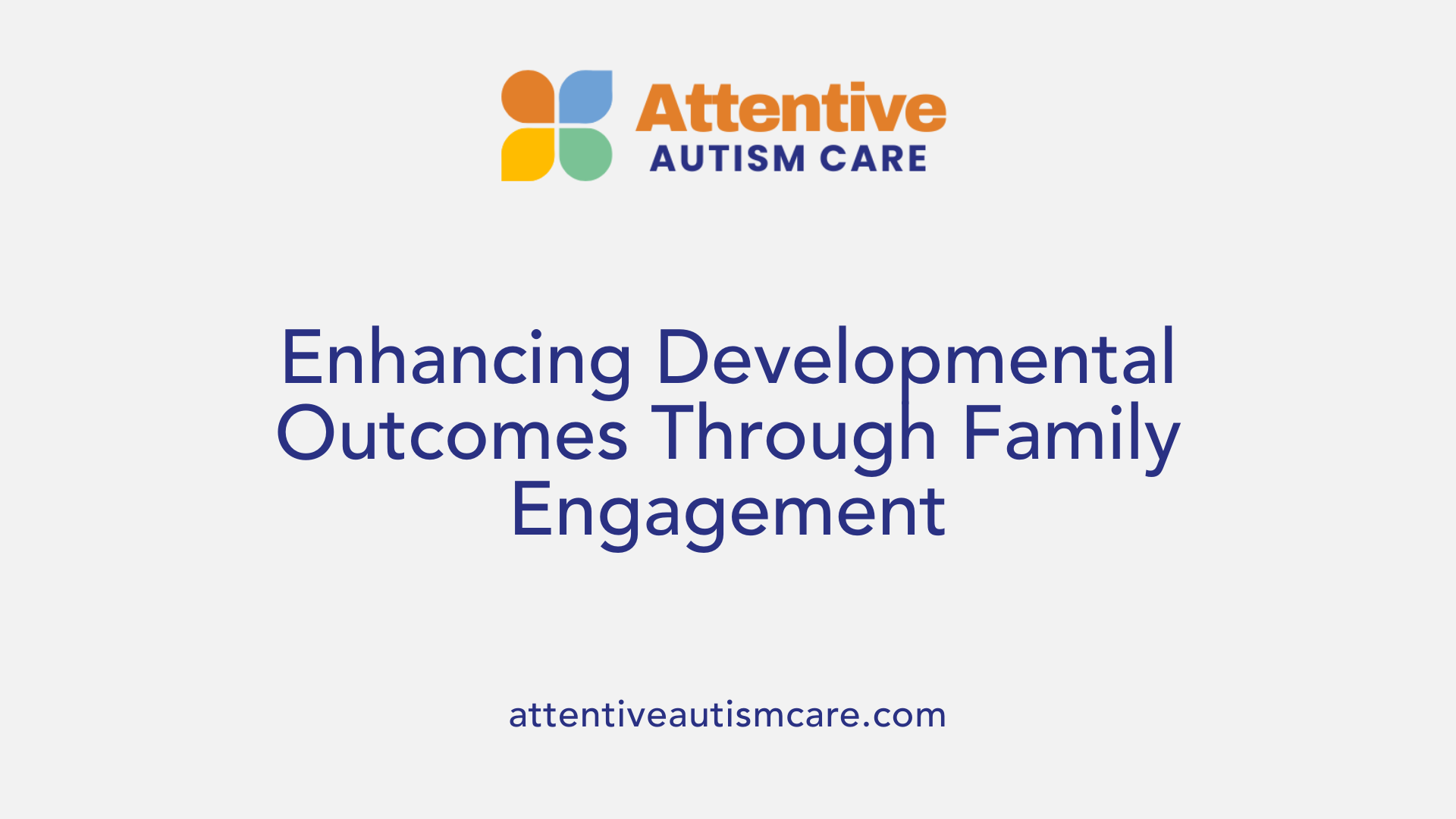
What is the role of family therapy in autism support?
Family therapy is a vital part of autism support, focusing on actively involving family members in their loved one’s care. It helps improve communication, understanding, and coping skills within the family, making the environment more nurturing and supportive.
Therapists assess family dynamics and develop personalized plans that align with the family’s values and goals. Techniques such as Applied Behavior Analysis (ABA), Cognitive Behavioral Therapy (CBT), and Family Systems Therapy are used to address specific challenges.
A primary objective is to enhance social interaction skills and emotional regulation, which are often areas of difficulty for individuals with autism. Family therapy also provides emotional support to caregivers, helping reduce stress and prevent burnout, which can negatively affect both the family and the individual.
By fostering collaboration among families, therapists, and educators, family-centered care creates a cohesive support network. This collective effort supports positive developmental outcomes and helps families navigate key transitions, such as starting school or accessing adult services.
How does family therapy support social and communication skills?
Effective family therapy uses visual aids, active listening, and role-playing to improve social and communication skills. These techniques help family members learn new ways of interacting and understanding each other.
Therapies like Naturalistic Developmental Behavioral Interventions (NDBIs) promote natural settings for skill-building, often involving caregivers directly in intervention strategies. Caregiver-mediated interventions enhance the social engagement and communication abilities of children with ASD.
Furthermore, structured routines, visual schedules, and positive reinforcement foster skill development, creating a predictable and secure environment for the child.
How does family therapy support emotional well-being and family cohesion?
Family therapy addresses emotional wellness by creating a safe space for sharing feelings, reducing misunderstandings, and strengthening relationships.
It teaches stress management and coping strategies, such as mindfulness and routine management, which help families handle daily challenges.
Building resilience through open communication and problem-solving techniques fosters a sense of hope and empowerment. This emotional stability benefits both the individual with autism and other family members.
What strategies help in addressing family dynamics for better support?
Successful family support involves improving relationships and resolving conflicts. Methods such as family counseling teach communication techniques like active listening and clear expression.
Creating routines and visual supports enhances predictability, which can reduce anxiety and behavioral issues.
In addition, emotional support networks, professional counseling, and community resources serve to bolster family resilience.
| Aspect | Approach | Benefit | Details |
|---|---|---|---|
| Communication | Visual aids, active listening | Better understanding and interaction | Encourages clarity, patience, and engagement |
| Emotional Support | Stress reduction programs, mindfulness | Improved emotional resilience | Strengthens coping skills and mental health |
| Routine Management | Visual schedules, consistent routines | Stability and predictability | Reduces anxiety and behavioral challenges |
| Family Engagement | Collaborative decision-making | Increased trust and support | Empowers families in intervention planning |
Overall, family therapy enhances developmental and emotional outcomes through tailored interventions, increased family involvement, and ongoing support systems. Embracing these strategies results in more resilient families and better quality of life for individuals with autism.
Impact of Family Support on Treatment Outcomes and Long-term Well-being
How does family support influence treatment outcomes in autism?
Family involvement is a central factor in successful autism interventions. When families actively participate in therapy, such as Applied Behavior Analysis (ABA) or naturalistic developmental behavioral interventions (NDBIs), they often see better progress in their child's social skills, communication, and behavior management. Parents and caregivers who are well-informed and engaged in treatments like Project ImPACT or JASPER tend to adhere more closely to intervention plans, which results in more consistent learning opportunities for the child.
Supportive family environments also reinforce positive behaviors and emotional regulation, creating a stable setting conducive to growth. Family-centered care models, highlighting collaboration and empowerment, further amplify treatment success by aligning goals and fostering trust between families and professionals. Addressing early caregiver stress through techniques like mindfulness or Acceptance and Commitment Therapy (ACT) improves mental health, enabling caregivers to be more present and effective.
How does reducing caregiver stress and improving mental health impact long-term outcomes?
Caregivers often face high levels of stress, which can hinder effective implementation of interventions and affect the family dynamic. Providing emotional support, resources, and stress management strategies help parents and family members cope better with the challenges of raising a child with autism.
When caregiver stress is reduced, families report higher satisfaction with services, greater patience, and improved communication. This positive environment encourages better social interactions, reduces family conflicts, and helps build resilience. Over time, these improvements contribute to more stable family relationships and better mental health outcomes for all members.
How can enhancing lifelong developmental and emotional stability benefit families?
Consistent family involvement and emotional support promote long-term stability for individuals with ASD. Fostering open communication, creating routines, and establishing visual schedules help children develop independence and emotional regulation skills.
For families, ongoing support and education empower them to navigate transitions such as starting school, entering the workforce, or accessing adult services. By strengthening family bonds and emotional well-being, these approaches contribute to a more resilient family unit, ultimately supporting the lifelong developmental and emotional health of individuals with autism.
Benefits of Family Therapy for Long-term Quality of Life
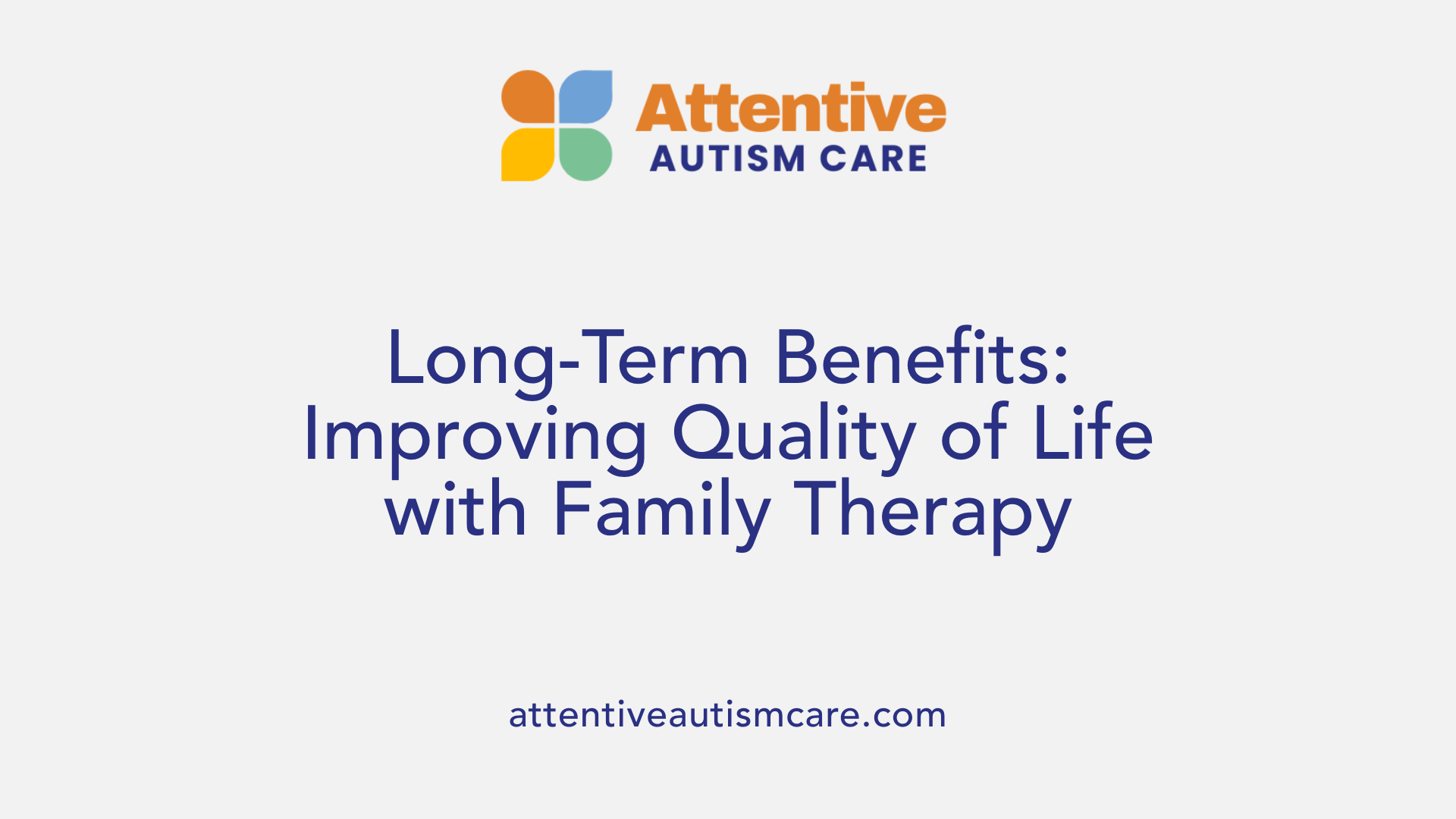
What are the benefits of family therapy for individuals with autism and their families?
Family therapy plays a vital role in enhancing the overall well-being and stability of families with members on the autism spectrum. It fosters improved communication and strengthens family cohesion, helping members better understand and support one another.
A significant advantage of family therapy is increased satisfaction with services, as families are actively involved in developing and implementing intervention plans. This collaborative approach ensures that support strategies align with family goals and routines, creating a more consistent environment for the individual with autism.
The therapy also provides crucial support during developmental transitions such as starting school, entering the workforce, or accessing adult services. By preparing families for these changes, it promotes a smoother adaptation process, reducing stress and uncertainty.
Creating supportive environments is essential for lifelong stability. Family-centered approaches include education, strategy training like ABA and CBT, and fostering emotional resilience. These efforts contribute to positive long-term outcomes, allowing individuals with autism to thrive socially, emotionally, and behaviorally.
The integration of tailored communication tools, routines, and behavioral interventions ensures sustained progress and stability. Overall, family therapy enables families to develop effective coping mechanisms, improve relationships, and nurture a nurturing environment that supports growth and resilience.
| Aspect | Description | Additional Notes |
|---|---|---|
| Communication & Cohesion | Strengthens family bonds and understanding | Use of visual aids, active listening |
| Service Satisfaction | Increased trust and collaborative decision-making | Family involvement in planning |
| Developmental Transitions | Supports smooth transitions in life stages | Preparation for school, work, adult services |
| Lifelong Stability | Promotes emotional and behavioral resilience | Consistent routines, positive reinforcement |
Embracing family therapy as part of ongoing support leads to lasting positive effects, equipping families to face future challenges with confidence and hope.
Effective Approaches and Evidence-Based Interventions in Family Therapy
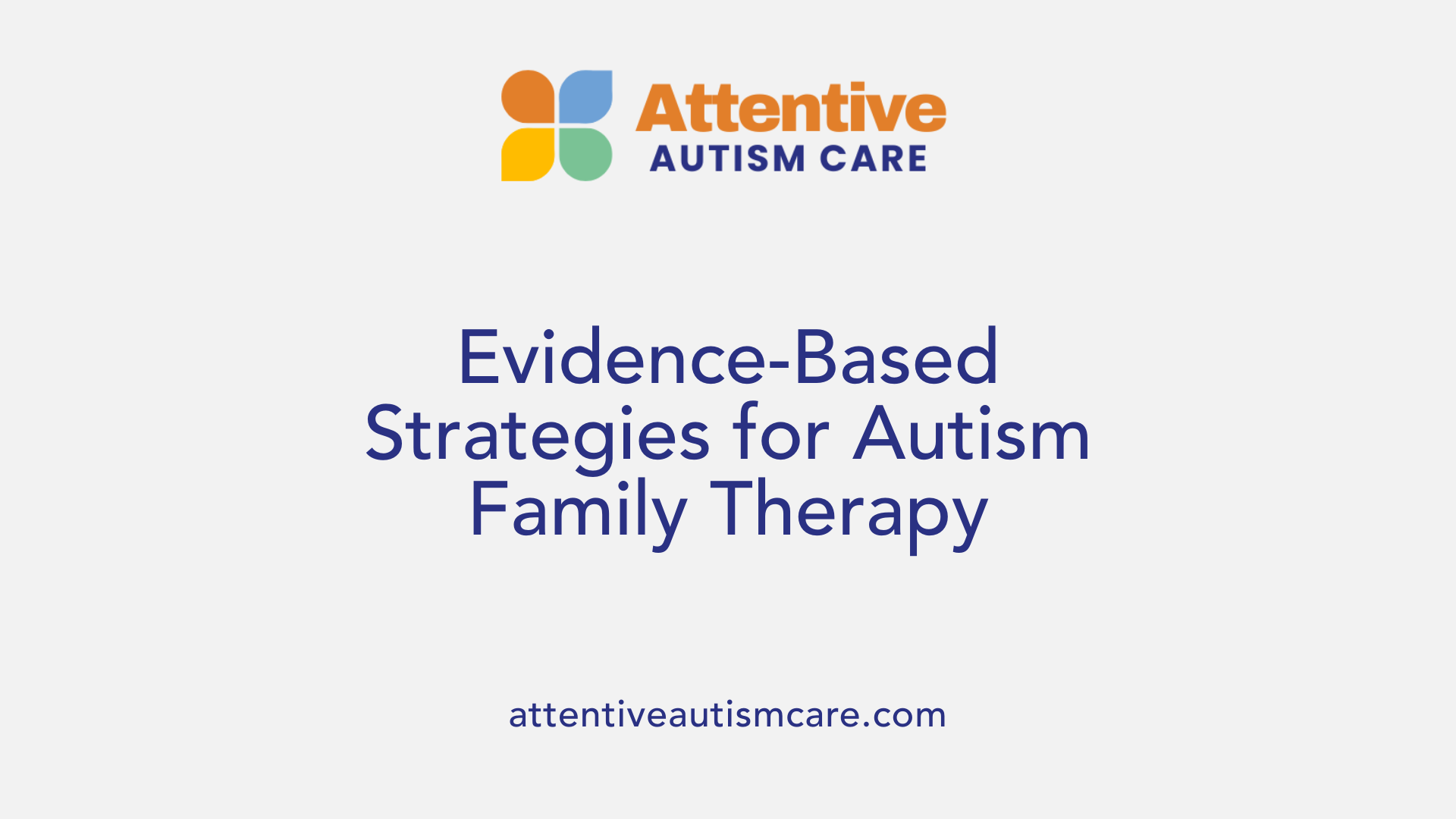
What are some effective family therapy approaches for autism support?
Supporting families with members on the autism spectrum involves a variety of tailored, evidence-based approaches designed to improve communication, emotional regulation, and overall family dynamics.
A widely used model is autism family therapy, which emphasizes collaboration and empowerment. This approach helps families understand autism better and develop practical coping strategies. To enhance effectiveness, therapists often incorporate established techniques such as visual aids, routines, and behavioral strategies to foster better understanding and daily functioning.
Among the most prominent intervention methods are Applied Behavior Analysis (ABA), DIRFloortime, and Naturalistic Developmental Behavioral Interventions (NDBIs). ABA focuses on behavior modification through positive reinforcement, teaching new skills and reducing maladaptive behaviors. DIRFloortime emphasizes emotional and relationship development, encouraging spontaneous social engagement. NDBIs blend developmental and behavioral strategies in natural settings to promote social-communication skills.
Caregiver-mediated interventions like Project ImPACT and JASPER involve training parents and caregivers to implement therapeutic techniques. These strategies not only improve the child's social and communication skills but also reduce family stress and increase parental confidence.
Assessments conducted by multidisciplinary teams guide individualized treatment plans, ensuring therapy addresses each family's unique needs. This collaborative evaluation process supports the creation of personalized strategies that foster stronger family bonds, boost emotional well-being, and facilitate developmental progress.
Overall, effective family therapy approaches for autism combine evidence-based interventions with a family-centered mindset. They aim to strengthen communication, reduce behavioral challenges, and build resilience within the family unit, paving the way for healthier relationships and better quality of life for individuals with autism.
Fostering a Supportive and Resilient Family Environment
In conclusion, family therapy is a vital component of comprehensive autism care. When families are actively involved, supported, and empowered through evidence-based, family-centered approaches, the outcomes for individuals with autism significantly improve. These therapies not only enhance developmental and emotional skills but also reduce family stress, promote resilience, and create enduring support networks that span across life stages. Embracing collaborative, personalized, and accessible family therapy strategies ensures that families can navigate the challenges of autism with confidence and hope, ultimately fostering brighter futures for individuals with ASD and their loved ones.
References
- Exploring Autism Family Therapy: Benefits and Techniques
- The Importance of Family-Centered Care: Enhancing Autism ...
- Effective Autism Family Therapy Strategies
- Advances in Supporting Parents in Interventions for Autism ...
- Supporting Families With Autistic Children
- How Autism Family Counseling Can Support Your Family
- The Importance of Family-Centered Care: Enhancing Autism ...



































































































